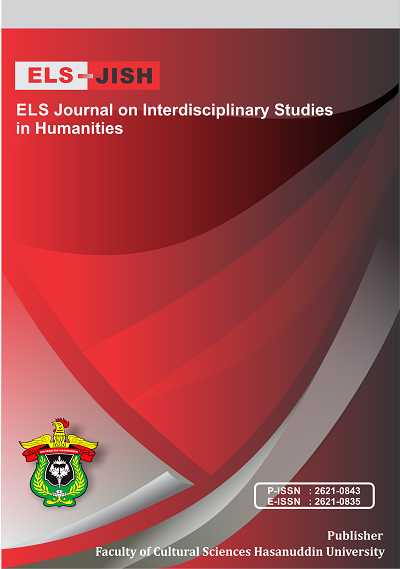Translation Analysis: Syntactic, Semantic, and Pragmatic Strategies Used in Translating A Website of an Academic Institution
DOI:
https://doi.org/10.34050/elsjish.v5i3.23176Keywords:
Translation Analysis, Website Translation, Syntactic, Semantic, Pragmatic StrategyAbstract
This research aims to discover the emerging translation strategies and the types of translation strategies most frequently used on a website of an academic institution. In finding the data, the researcher employs the descriptive qualitative method by applying the translation strategy theory proposed by Andrew Chesterman in the form of syntactic, semantic, and pragmatic strategies on a website of an academic institution such as the Universitas Hasanuddin website. There are 11 emerging translation strategies on the website; 4 Syntactic Strategies (Literal, Loan/Calque, Transposition, and Phrase Structural Change), 4 Semantic Strategies (Synonymy, Hyponymy, Distribution Change, and Pharaprase), and 3 Pragmatic Strategies (Explicitness Change, Information Change, and Transediting). The result shows that the most frequently used translation strategy is Syntactic Strategies (Literal 60% or 44 data, Loan/Calque 23% or 17 data, Transposition 8% or 6 data, and Phrase Structural Change also 8% or 6 data). Then the second one is Semantic Strategies (Synonymy 7% or 1 datum, Hyponymy 7% or 1 datum, Distribution Change 64% or 9 data, and Pharaprase 21% or 3 data), and last is Pragmatic Strategies (Explicitness Change 8% or 1 datum, Information Change 85% or 11 data, and Transediting 8% or 1 datum).
References
Al-Obaydi, L. H., Jawad, Z. A., & Rahman, F. (2022). Class-home Connection Using Communication Technology and its Impact on Anxiety Reduction and Academic Performance. Al-Adab Journal, 1(141), 53-66.
Hariyanto, S. (2015). Website Translation (with special reference to English-Indonesian language pair) (Issue November 2015).
Latief, M. R. A., Saleh, N. J., & Pammu, A. (2020). The effectiveness of machine translation to improve the system of translating language on cultural context. IOP Conference Series: Earth and Environmental Science, 575(1). https://doi.org/10.1088/1755-1315/575/1/012178
Machali, R. (2000). 294208348-Pedoman-Bagi-Penerjemah-oleh-rochayah-machali.pdf.
Newmark, P. (1988). A Textbook of Translation. In Text.
Rahman, F. (2017). Cyber Literature: A Reader – Writer Interactivity. International Journal of Social Sciences & Educational Studies, 3(4), 156–164. https://doi.org/10.23918/ijsses.v3i4p156
Rahman, F. F., & Rahman, F. (2019). Translation or Intertextuality: A Literature Comparative Analysis of “The Young Dead Soldiers Do Not Speak” by Archibald MacLeish and “Krawang Bekasi” by Chairil Anwar. Elsya: Journal of English Language Studies, 1(3), 110-117.
Suherman, L. O. A., Rahman, F., Eryck, M. F., & Munirah, M. (2022). Plagiarism Occur In Students’academic Work, Exploring Impact The Efl (English As Foreign Language) Undergraduate Students’plagiarism In Theses Writing. ZONAsi: Jurnal Sistem Informasi, 4(1), 52-63.
Sukmawaty, Rahman, F. F. & Andini, C. (2022). Covid-19 Pandemic and Axiology of Communication: A Study of Linguistic Phenomena. IJISRT, 7(4).
Verity, D. P., & Larson, M. L. (1986). Meaning-Based Translation: A Guide to Cross-Language Equivalence. The Modern Language Journal. https://doi.org/10.2307/328112
Downloads
Published
How to Cite
Issue
Section
License
Copyright (c) 2022 Muhammad Ridha Anugrah Latief, A.ST.Aldilah Khaerana, Andi Inayah Soraya

This work is licensed under a Creative Commons Attribution-NonCommercial-ShareAlike 4.0 International License.






